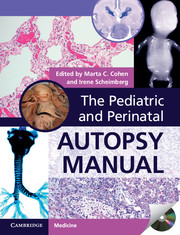Book contents
- Frontmatter
- Contents
- List of contributors
- Foreword
- Preface
- Acknowledgments
- 1 Perinatal autopsy, techniques, and classifications
- 2 Placental examination
- 3 The fetus less than 15 weeks gestation
- 4 Stillbirth and intrauterine growth restriction
- 5 Hydrops fetalis
- 6 Pathology of twinning and higher multiple pregnancy
- 7 Is this a syndrome? Patterns in genetic conditions
- 8 The metabolic disease autopsy
- 9 The abnormal heart
- 10 Central nervous system
- 11 Significant congenital abnormalities of the respiratory, digestive, and renal systems
- 12 Skeletal dysplasias
- 13 Congenital tumors
- 14 Complications of prematurity
- 15 Intrapartum and neonatal death
- 16 Sudden unexpected death in infancy
- 17 Infections and malnutrition
- 18 Role of MRI and radiology in post mortems
- 19 The forensic post mortem
- 20 Appendix tables
- Index
Foreword
Published online by Cambridge University Press: 05 September 2014
- Frontmatter
- Contents
- List of contributors
- Foreword
- Preface
- Acknowledgments
- 1 Perinatal autopsy, techniques, and classifications
- 2 Placental examination
- 3 The fetus less than 15 weeks gestation
- 4 Stillbirth and intrauterine growth restriction
- 5 Hydrops fetalis
- 6 Pathology of twinning and higher multiple pregnancy
- 7 Is this a syndrome? Patterns in genetic conditions
- 8 The metabolic disease autopsy
- 9 The abnormal heart
- 10 Central nervous system
- 11 Significant congenital abnormalities of the respiratory, digestive, and renal systems
- 12 Skeletal dysplasias
- 13 Congenital tumors
- 14 Complications of prematurity
- 15 Intrapartum and neonatal death
- 16 Sudden unexpected death in infancy
- 17 Infections and malnutrition
- 18 Role of MRI and radiology in post mortems
- 19 The forensic post mortem
- 20 Appendix tables
- Index
Summary
Marta Cohen and Irene Scheimberg, pediatric pathologists of international repute, have recruited a distinguished panel of authors for this book. Their assignment is to provide general pathologists with up-to-date information on perinatal and pediatric pathology. As a manual, it emphasizes techniques for examining pediatric postmortem and surgical specimens, including histopathology. But this is much more than a procedure manual. The book is brim full of current information about common and obscure pediatric disease.
Chapter by chapter, the assembled experts have laid out detailed approaches to perinatal and pediatric specimens. The descriptions of dissections are so cogent they could well be read aloud to an inexperienced prosector while he or she conducts an examination. Even experienced pediatric pathologists will find techniques and methods that they had not considered or, perhaps, not even known.
In a volume of 436 pages, the authors have wisely emphasized the approach to specific problem areas. These include immature fetuses and infants, growth restriction, excessive body growth, sudden unexpected death in early life, pediatric infectious diseases, problems related to pediatric intensive care, etc. Pertinent information is provided on pathologic anatomy, histopathology, chemistry, microbiology, and molecular genetics. An entire chapter on pediatric radiology is a feature not usually found in pathology textbooks. Still another special chapter deals with perinatal and pediatric forensic pathology.
Photographs of actual dissections provide exquisite detail that complements the text. Other color illustrations add appreciably to both the appeal and the teaching value of the book. Tables with classifications and algorithms enhance the information in each chapter. And the relatively brief reference lists are a pleasant departure from the massive multipage bibliographies found in most modern textbooks of pediatric pathology.
- Type
- Chapter
- Information
- The Pediatric and Perinatal Autopsy Manual , pp. ix - xPublisher: Cambridge University PressPrint publication year: 2000

